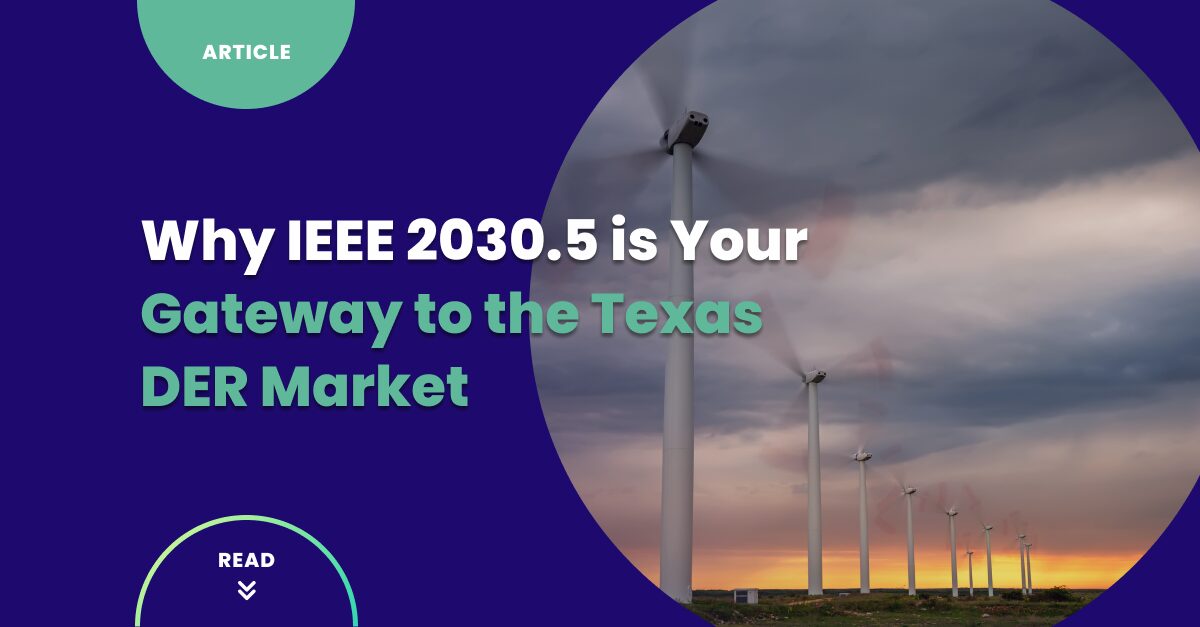Why IEEE 2030.5 is Your Gateway to the Texas DER Market

The Texas energy market is a world unto itself. Operating on its own independent grid, the Electric Reliability Council of Texas (ERCOT), the state has long navigated its unique energy challenges. But as Distributed Energy Resources (DERs) like solar and battery storage proliferate, a new layer of complexity—and opportunity—is emerging. For OEMs, developers, and aggregators, recent regulatory changes aren’t just a hurdle; they’re a clear signal that the time to act is now.
The Urgency: Texas’s Shifting DER Landscape
The urgency is twofold. First, one of the state’s largest utilities, AEP Texas, has already adopted the IEEE 1547-2018 standard for interconnection, effective January 1, 2024. For DER technology to be sold and interconnected in AEP’s territory, it must meet these new requirements.
Second, the Public Utility Commission of Texas (PUCT) is finalizing new DER interconnection rules under Project No. 54233. This statewide effort signals that what AEP Texas has done is not an isolated event but a preview of what’s to come across the entire ERCOT grid. For companies that move quickly, this is a chance to not just comply, but to gain a significant first-mover advantage.
The Problem: Navigating the “Big Three” Protocols
IEEE 1547-2018 is a powerful standard that defines how DERs must interact with the grid to ensure safety and reliability. But here’s the catch: the standard requires DERs to support a communication interface with at least one of three specified protocols: DNP3, SunSpec Modbus, or IEEE 2030.5.
This choice is a critical business decision. Many manufacturers, seeking the easiest path to compliance, may opt for a protocol that seems simpler at first glance. However, a short-sighted choice could limit their product’s functionality and prevent it from participating in the most lucrative, next-generation grid programs.
The Solution: Why IEEE 2030.5 (CSIP) is the Strategic Choice for Texas
While all three protocols can get you compliant, IEEE 2030.5 is the most flexible and future-proof option, especially for the Texas market. Its strength lies in its ability to directly control smart devices and securely manage two-way communication.
This capability is not just a technical detail; it’s a strategic asset in a market like Texas. The ERCOT Aggregate Distributed Energy Resource (ADER) Pilot Program, which is expanding its capacity to a significant 160MW, explicitly references IEEE 2030.5 as the communication standard. For DERs to participate in this groundbreaking program—and provide crucial services to the Texas grid—they need a protocol designed for direct, secure, and flexible control.
Codibly’s IEEE 2030.5 Accelerator is a microservice-based solution that is pre-tested with industry tools to ensure faster certification and regulatory sign-off. This helps you overcome the complex implementation challenges of device mapping and high-volume data, allowing you to focus on your core product.
This same technology can also position you to unlock other emerging opportunities in Texas. For example, the state is also rolling out the Texas Energy Fund’s Backup Power Package Program, which will provide funding for backup power at critical facilities. A DER product equipped with a future-proof communication protocol would be ideally suited to serve this new and vital market.
The Codibly Advantage: Your Partner in Texas
Navigating the Texas regulatory landscape doesn’t have to be a multi-year headache. Codibly’s pre-built, certification-ready deployment of the IEEE 2030.5 protocol is designed to save you time and money.
We help you achieve compliance faster by providing a robust software solution and leveraging our network of trusted certification lab partners. This means you can bypass the long development cycle and get to market ahead of your competition. We help transform compliance from a logistical burden into a strategic advantage, ensuring your technology is ready to compete and thrive in one of the world’s most dynamic energy markets.

Contact us
Ready to accelerate your Texas market entry?
Contact us for a personalized consultation on your IEEE 2030.5 compliance roadmap.
